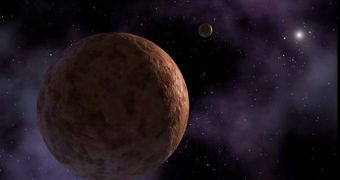A part of the international astronomical community believes that the outer fringes of our solar system may contain planets the size of the Earth or Mars. While the idea previously seemed implausible, new data seem to point out that this belief may not be that far-fetched. Even if this turns out to be true, scientists still have no way of determining directly whether this is true or not. Even telescopes commissioned in 2009 are too weak to peer that far in the outer solar system, and make out larger planets from the vast field of space debris that exists beyond the orbit of Pluto, Space reports.
The same experts also believe that, if such a planet exists, then it would undoubtedly resemble a frozen version of Mars or Earth. But the kicker is that some astronomers think that these planets may not be alone at their respective locations, very far away from the Sun. “When the solar system's story is finally written, it's much more likely that it will have closer to 900 planets rather than the nine that we grew up with,” Southwest Research Institute (SwRI) planetary scientist Alan Stern explains. The research center is based in Boulder, Colorado.
Stern and others expect to discover a lot of bodies the size of Pluto or Ceres. The International Astronomical Union (IAU) has termed these objects dwarf planets, but many experts do not agree with this definition. Scientists believe that numerous other bodies similar to these two exist beyond Pluto's orbit, but say that only a few larger ones, the size of the Earth for example, may exist. Each of the structures, they go on to say, would basically represent a time capsule that would give researchers a view back in time, to the earliest days of the solar system.
Most experts proposing the existence of other Earth-sized planets say that they most likely reside in the Oort Cloud, a debris field that lies beyond the Kuiper Belt where Pluto is found. Between the two formations, the dwarf planet Sedna spins around the Sun in a very peculiar orbit, which seems to indicate that there is another planet influencing its orbit. However, these eccentricities may also be caused by other factors, and most astronomers believe that a Mars-sized planet at that location would have already been detected.
“Once you go beyond the Kuiper Belt, to the Sedna region or the Oort Cloud, you can always hide things by putting them farther away. For the Kuiper Belt we can already say there is nothing Earth or Mars sized, as its dynamical effects would be easily seen,” astronomer Mike Brown explains. The expert, based at the California Institute of Technology (Caltech), led the team that discovered the dwarf planet Eris.

 14 DAY TRIAL //
14 DAY TRIAL //